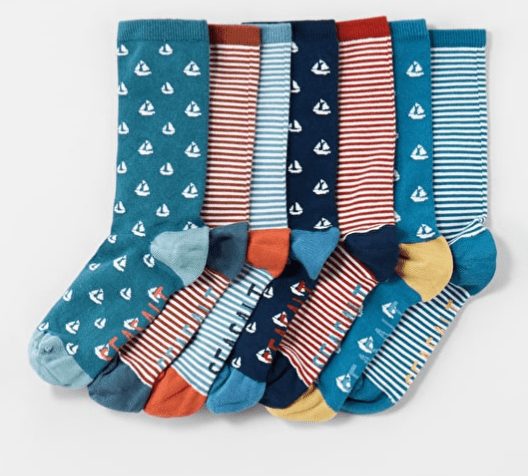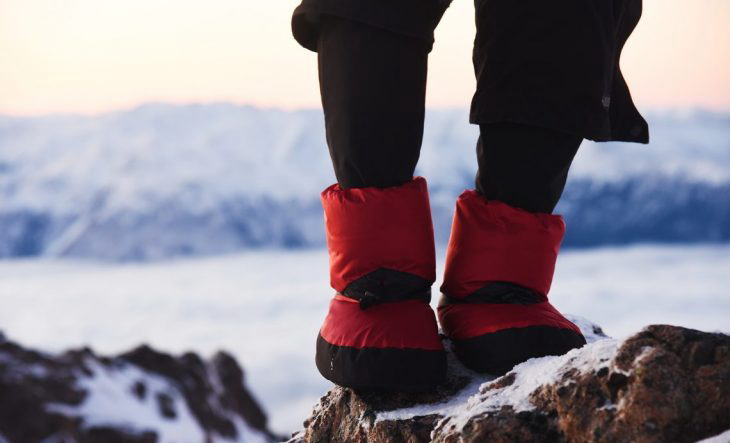Hiking the East Coast Trail is one of the best ways to experience Newfoundland. With an elaborate network of coastal trails, outdoor enthusiasts can take advantage of a broad spectrum of hikes and coastal walks, from super easy to multi-day backcountry adventures. With something for everyone, you can choose a simple sunset walk with wine glass in hand to a multi-day adventure that lets you go further and explore more. Regardless of your adventurer style, we just want you to be happy, and we especially want your feet to be happy. Here are some tips to keep you and your two best friends comfortable and happy on your next Newfoundland East Coast Trail adventure:
 1: Good Socks
1: Good Socks
With so much focus on boots and shoes, it’s easy to forget about socks, and looking at all the sock options at your local outdoor store is enough to make you go bananas. Whatever color and style you choose, it’s almost always better to go with a merino wool sock as opposed to cotton or synthetic since merino wool will keep your feet warm even when wet (cotton won’t) and will not absorb odors as much as a synthetic sock (which is still better than cotton but not our personal favorite).
2: Water Proof Hiker
Look for a waterproof hiking boot with a full gusseted tongue, one that you can step into a puddle with and still stay dry. If you’re doing full-day or overnight hikes it’s best to invest in a full leather hiking boot. If you’re limiting your adventures to coastal walks and half-day excursions, a light weight hybrid hiker is a good option.
3: Sole
Choose a non-slip sole like vibram that offers good grip on rocks and uneven terrain even in wet and cool conditions. A slip and fall in the wilderness can quickly turn into a life threatening emergency so limit your chances of falling with a good quality sole.
4: Ankle Protection
Ankle sprains and strains can stop a fun excursion dead in it’s tracks. Most people don’t spend a lot of time walking on uneven terrain which means our ankles and supportive muscles aren’t as strong as we’d like them to be. This makes it easy to twist and roll your ankle, especially during the first few hikes of the season. Help your ankles stay safe by choosing high-cut boots and hikers that offer ample ankle protection.
5: Blisters
Armies have failed because of blistered feet, so don’t think a blister won’t stop you. New shoes mixed with increased activity are a recipe for blisters, especially if you’re hiking daily or on a multi-day East Coast Trail hike. When it comes to blisters, preventing them with proper footwear and socks is the primary objective, and aggressively treating the first sign of any blister is second. Inspect your feet regularly, keep them clean and dry, and treat hot spots with moleskin to prevent them from getting worse.
6: Extra Socks
Because socks are so important, we don’t feel bad about mentioning them twice. Putting an extra pair of socks into a plastic bag and stuffing them into your pocket will go a long way in keeping your feet warm, dry, and happy.
7: Break in Footwear
The first time you wear those shiny new hikers shouldn’t be on an expedition. Brand new shoes and boots take time to conform to the unique shape of your foot, and your risk of getting blisters is higher when footwear isn’t properly broken in. A week before your trip, start wearing your new hikers or boots, even if it’s just around the house or airport. Your feet will thank you.
8: Blister Kit
On your Newfoundland hiking adventure, be sure to pack a blister treatment kit consisting of blister prevention cloth like moleskin, small fold up scissors, medical tape, alcohol swabs, and an antibiotic ointment like polysporin. If you’re wondering what moleskin is, it’s a thick heavy cotton fabric that can be stuck to the skin on your feet to prevent rubbing and blistering. You can use the scissors to cut the right sized shape and the alcohol swab to prep and clean your skin before sticking moleskin or tape to it. If you do get a blister, don’t pop it (this can cause an infection). Keep it dry, clean, and covered. Prevent further irritation and treat any signs of a local infection with antibiotic ointment.
 9: Booties / Camp Slippers
9: Booties / Camp Slippers
These are a great addition to any backpack and, in our opinion, a must have on any overnight hike. After all, hikers are great for hiking, but not so great for standing around camp or relaxing beside the fire. Your hiking boots also need an opportunity to dry out, and your feet need a break from being jammed into those boots. Taking off your hiking shoes and slipping into a pair of warm plush down filled slippers lets your toes stretch out and your feet relax and heal. There are a lot of great products like these on the market that are affordable, lite, and easily stuffed into a pocket or backpack.
10: Moisturize Dry Feet
If you’re prone to dry and cracked skin on your feet, take special care to treat your feet and prevent any cracks or cuts as much as possible. Having an open cut on your foot that’s crammed into a sweaty hiking boot all day is a recipe for infection, which can put a real damper on your Newfoundland hike. A week before your trip, take particular care of your feet to ensure they’re in tip top shape in anticipation of your adventure.




 9: Booties / Camp Slippers
9: Booties / Camp Slippers


